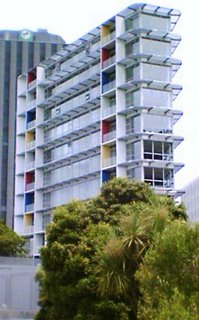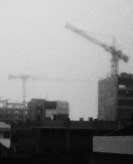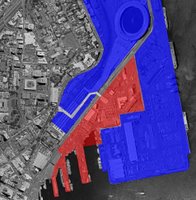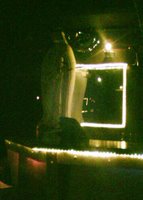We've just passed the halfway mark of 2006, and I'm just ahead of schedule on
my project: I have now had a drink this year at exactly three quarters of the bars in central Wellington. It's a bit of a moving target, since some bars closed before I could get to them, while others have closed and reopened since I visited, meaning that I'll have to go back! It's a hard life.
But seriously, some bars are definitely hard work, such as
the current mystery bar. Some of the guesses are getting pretty close, but none of them indicate that the guesser has actually been inside the place in question: if you've been there, you'll recognise it (presuming you didn't partake of too much Jack Daniels while you were there).

Along the way, I've been able to pop into some much more salubrious establishments, and whenever it was feasible (and sometimes when it wasn't) I have ordered a Martini. I've realised that I'm long overdue to publish a Martini review, so building on from
my first four instalments, here is the latest batch of fresh, (mostly) delicious, gin-based goodness.
Copita: 8.5Classic ingredients (Tanqueray, Noilly Prat, three olives) were always going to give a classy drink, and the results didn't disappoint. Strong herb and citrus aromas led on to an icy-cold drink with a rich oily mouthfeel, though let down a tad by a somewhat fierce finish.
Coyote: 6.5I didn't see the making of this Martini, but I don't think the ingredients were the best. The faint aroma was gin-dominated, and while the drink was admirably cold and clear with a peppery bite, it quickly degenerated into a thin junipery body and a hot, unpleasantly bitter finish. The garnish consisted of two olives pierced lengthwise by two short sticks.
Eclipse: 5.5The bartender placed ice in the Martini glass, stirred Bombay Sapphire and Martini brand vermouth in a shaker with more ice ... then went off to serve another customer, leaving it to dilute. The result looked clear and cold, but had ice chips floating on the surface. The aroma and taste were both slightly sweet and citrusy, and the finish was watery and stale-tasting. The use of two cheap black olives in place of the canonical green didn't help either.
Establishment: 9An admirably old-fashioned approach, using Tanqueray and Noilly, with enough of the latter to allow the complexity of the French vermouth through. The drink was poured right to the brim of a small glass, the way that it would have been in the Forties, and garnished with two large, fresh, delicious olives. Wonderfully balanced and easy to drink. (Note: this was at the back bar, not in the main bar(n), and I specifically asked for Matthew to make it. Your mileage will definitely vary.)
One Red Dog (Kumutoto): 8Despite the barman's nervousness, he was happy to take directions, which at least meant that I got it made exactly the way I like it. Tanqueray, Noilly (no, don't chuck it
all out!), stirred (gently! gently! you'll bruise the gin!), olives (three please). It was all looking good, with a crystal-clear body and a gentle haze of condensation outside the glass, and I was licking my lips and thanking the barman as he brought out some water for my companions when ... SMASH! He brought one of the water glasses down on the side of the Martini glass, shattering one side of it into a thousand gin-soaked fragments. Profusely apologetic, he offered to bring a fresh one to the table, and when he did, the results were very, very good. However, a Martini is all about quiet confidence and delicate poise, all of which is incompatible with having a glass smashed in front of you, so I had to take off at least half a point.
Gibbon's Bar: 2I've
reviewed this at length before, but I think it's worth a recap. The staff were earnest and pleasant, but had clearly not only never made a Dry Martini before, but had only vaguely ever heard of one. They knew enough not to just serve up a glass of Italian vermouth, but the result was little better. After carefully specifying gin and asking for a 5-to-1 ratio (best not to attempt anything too dry in such a place), I then had to carefully explain to the incredulous bartender that no, I didn't mean 5 parts vermouth to one of gin, but the other way around.

This seemed to evoke severe cognitive dissonance in the poor bartender, and I eventually managed to end up with something neither shaken nor stirred, but that at least had slightly more gin than vermouth. Well, I presume it was gin, but I couldn't tell, and didn't want to know, what brand of gin was involved: it was poured from an invisible dispenser above the bar. To top it off, three large ice cubes were plonked into the Martini glass, resulting in something that bore as little resemblance to a Dry Martini as the membership of Waterfront Watch does to the clientele of
Havana. I managed to force down a couple of sips before giving up, and I'm being very generous to give this 2 out of 10. Ladies and Gentlemen, I present to you: the worst Martini in Wellington.
Harem: 5I didn't see the ingredients, but I did hear the shaking, so I knew what to expect: watery and topped with ice chips. What I didn't expect was a straw! There was a strong gin aroma, but not much flavour. Hardly suprising, since one wouldn't expect subtlety and grace from
a place full of neon palm trees and papier-mache stalactites, and I'd recommend sticking to the "Sultan's Passion".
Good company, though.
Lido: 7.5This has always been a cafe rather than a bar, but the presence of a cocktail list nudges it barwards. Unlike
some similar places, they can back up their promises with some very creditable cocktail making. My Martini was crisp & cold, with a distinct herbal aroma, smooth rich flavour and two large olives.
Paradiso: 7They had no Tanqueray, so I went with South gin and Noilly Prat. The result was generally all present and correct, with the standard three olives and a restrained aroma and flavour, but something was definitely wrong with the presentation: it was served in a metal "glass"! I'm all in favour of innovation, but visual clarity is an important part of the Martini experience, so serving it in an opaque vessel is like encasing a diamond in lead. It also interferes with the tactile experience of sipping, and at least gives the illusion of affecting the taste and smell. The glass was branded "Absolut", which explains everything.
Pod: 8.5The barman was keen to do everything to my specification, asking me for my preferred make of gin (Tanqueray), level of dryness (7-to-1) and even the number of olives (two). The process was quite elaborate: he stirred the gin with ice and the olives; added ice to the glass; discarded the ice; poured vermouth into the glass; discarded most of that; then finally strained the chilled gin into the glass and added the olives. The result was cold and clear, with a pleasant yet undemonstrative nose and a smooth, oily palette The flavours were distinctly savoury (perhaps a result of adding the olives while stirring?) with herbal and liquorice overtones. Overall, it was sleek, uncomplicated and satisfying.
Red Square: 8.5They used Tanqueray, which was good, and Martini, which is less so. There were the usual three olives, and the result was served in a pleasantly traditional small glass. It had strong pepper and citrus aromas, and a smooth, cold body, and a slightly unusual, almost salty finish. Perhaps they were using brinier olives than usual, but whatever it was, I quite liked the savoury edge it brought to the drink.
Whitby's Piano Bar: 6.5Shaken and bland, with ice chips floating on the top, a watery body and a lack of flavour. Not good enough for a supposedly swish hotel bar.
Ponderosa: 8An all-round solid effort, with Tanqueray and Noilly, and the only non-standard touch was the use of a bamboo skewer for the three olives. Tasty and refreshing, but not spectacular.
Capitol: 9When a cocktail menu specifically lists four versions of the classic Martini, with increasingly premium varieties of gin, you should expect them to know what they're doing. And they do. I chose the Tanqueray Ten Martini for $17, and it was a bargain. The appearance was impeccable. The aromas were intoxicating and fascinatingly complex, with clearly separable notes from many different botanicals, including liquorice and grapefruit as well as the usual juniper berries. The body was rich and sumptuous, with deep and moreish flavours. While unapologetically alcoholic, it was deceptively easy to drink, and I had to restrain myself so as to savour it with the leisurely attention that it deserved.
So why only 9 out of 10? They didn't so much
garnish it as
cram it with olives: six olives on two separate sticks! This cluttered and detracted from what should have been a near-perfect drink, since the olive is supposed to be a grace note, not a dominating ingredient. It was a Sunday afternoon, so perhaps they felt that by law, I had to have a meal. Such a pity. Everything else was perfect: the clarity, the aroma, the taste, the company of a beautiful woman, the violet light of a late afternoon in winter. Next time, I'll specify the number of olives, and may aim even higher by trying a
Miller's gin Martini. I've never experienced the perfect Martini experience, and maybe the very concept is illusory ... ah, but a man's reach should exceed his grasp, or what's a Martini for?
 You'll probably have read in the Dominion Post and on the Wellingtonista about Remiro Bresolin's terminal illness. As Rodger mentioned, the greatest loss will obviously be to his family, but any Wellingtonian who appreciates our lively dining scene will feel a debt to Cavaliere Bresolin for bringing a touch of Carnevale to our town.
You'll probably have read in the Dominion Post and on the Wellingtonista about Remiro Bresolin's terminal illness. As Rodger mentioned, the greatest loss will obviously be to his family, but any Wellingtonian who appreciates our lively dining scene will feel a debt to Cavaliere Bresolin for bringing a touch of Carnevale to our town.

























 Along the way, I've been able to pop into some much more salubrious establishments, and whenever it was feasible (and sometimes when it wasn't) I have ordered a Martini. I've realised that I'm long overdue to publish a Martini review, so building on from
Along the way, I've been able to pop into some much more salubrious establishments, and whenever it was feasible (and sometimes when it wasn't) I have ordered a Martini. I've realised that I'm long overdue to publish a Martini review, so building on from 




